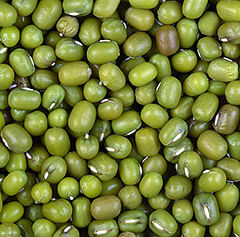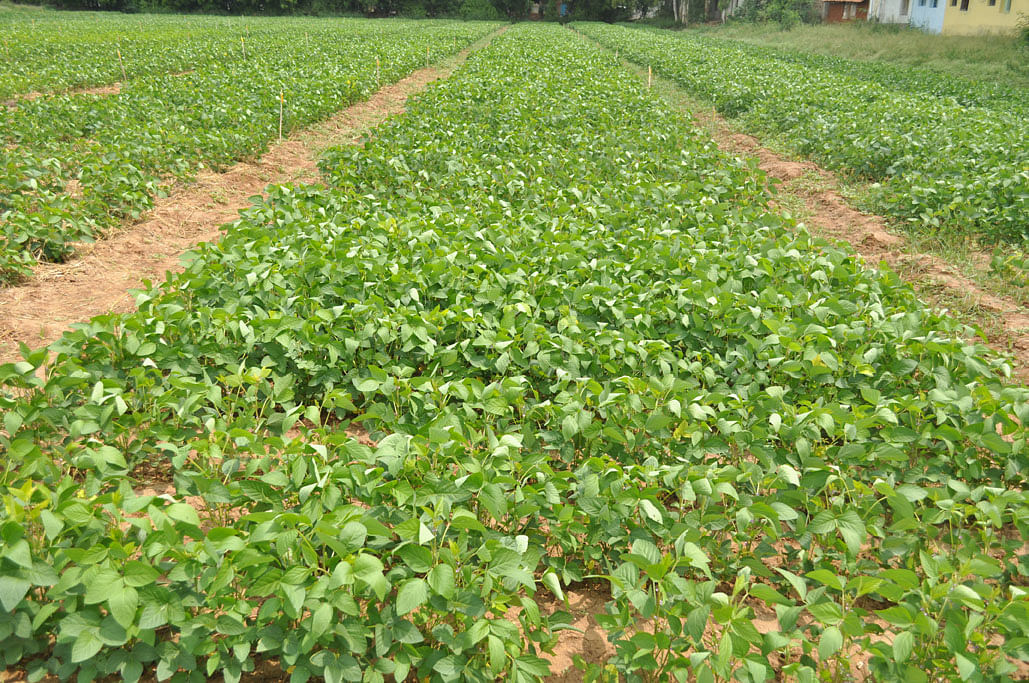
Common name- Moong daal or moong beans
Botanical name: Vigna radiata
Origin: India and central Asia
Introduction:
- Green gram is popularly known as Moong dal.
-
It is an oval shaped bean, green in color.
-
India is the largest producer and consumer of Green Gram. It is commonly cultivated throughout India.
-
In India, it is consumed in the form of split pulse and whole pulse.
Nutrition:
-
Green gram is rich in protein.
-
Green gram provides sufficient amount of fiber and iron.
-
As green gram is high in fiber, it is very easy to digest. Controlling blood pressure is another benefit of green gram.
Climate:
-
Warm and humid atmosphere suits to the cultivation green gram.
-
Temperature should be between 25°C to 35°C along with that moderate rain is required.
-
On other hand water logging and cloudy weather is harmful for the crop.

Season:
-
Green gram is mainly kharif season crop.
-
March-June period is quite suitable for the cultivation of green gram.
-
Cultivation of green gram is however common in all the three seasons.
Soil:
-
Maximum types of soils are suitable for the cultivation of green gram.
-
Soil should have good drainage capacity, for example, loamy soil and sandy loamy soil.
-
Saline soils and water logging conditions are not appropriate for the cultivation of green gram.
Fertilizers and Manure:
-
Required fertilizers at the time of sowing:
Phosphorus (P2O5): 25-40 Kg/ha
Nitrogen (N): 25 Kg/ha
-
FYM in the amount of 10 to 15 CL/ha should be included into soil at the time of preparation of soil.
Land preparation:
-
1 to 2 ploughing is required in field preparation.
-
Land should be free from weeds and should be well leveled.
-
After harvesting previous crop, immediate irrigation is required for the summer season crop.
-
Planking function is also required in summer season; it would help to stop loss of moisture from the soil.

Plant spacing:
-
In rabi and summer seasons required plant spacing- 30×10cm.
-
In Kharif season required plant spacing- 45×10cm.
Seed rates:
-
Kharif season- 12 to 16 Kg/ha.
-
Rabi and summer season- 20 to 25 Kg/ha.
-
It is recommended that seed should be sown at least at depth of 5 to 7 cm.
Variety:
-
CO 1- Duration of this variety is 135 days. It is of long duration and it is also suitable for rainfed.
-
ADT 1- Duration of this variety is 80 days. It is suitable for rice fallow.
-
JGG 1- Duration of this variety is 65 days. It can survive in the condition of drought.
-
KM 1- Duration of this variety is 65 to 70 days. It is tolerant YMV and pod borer.
-
K1- Duration of this variety is 70to75 days. It is resistant to drought conditions.
Harvesting:
Harvesting green gram on time and in smart way can maximize the quality of crop and minimize the loss of origin.
-
Harvesting should be done when 85% of pods are fully matured.
-
After threshing, it is required that seeds are separated and cleaned efficiently.
Irrigation:
-
As it is a rainfed crop, much irrigation is not required.
-
Drainage is very crucial for this crop as it is very much sensitive to water logging.
-
5 to 6 irrigation is required in summer season.
-
Frequent irrigation is required at an interval of 12-15 days.
-
Early pod filling and late flowering are very important phases for irrigation.
Yield:
-
For Kharif season- 600-700 Kg/ha.
-
For summer season- 1100-1300 Kg/ha.









